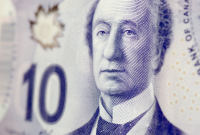Thank you for helping us meet our fundraising goal!
The federal government had originally hoped to remove a Parliament Hill memorial dedicated to Indigenous children who died and went missing from residential schools months earlier than actually happened last year, according to newly released documents.
Hundreds of tiny shoes, stuffed animals and flowers began appearing around the Centennial Flame in front of Parliament's Centre Block last spring, after the Tk'emlúps te Secwépemc Nation announced ground-penetrating radar had found the possible remains of about 200 children on the site of a former residential school near Kamloops, B.C.
The Parliament Hill memorial was one of many that popped up across the country as Canadians were confronted with the horrors Indigenous children faced when removed from their families and forced to attend these institutions over more than a century.
It became a place where Indigenous elders and tourists alike would stand in silence.
According to the documents, officials with Crown-Indigenous Relations and Northern Affairs initially wanted to hold a ceremony to remove the display last summer before the widely anticipated election campaign.
They also recommended departments create a plan for dealing with similar memorials in the future.
"The removal is being recommended, first and foremost, in order to ensure the preservation of these items," reads a memorandum prepared for the department's deputy minister and released to The Canadian Press through federal Access-to-Information legislation.
"Moreover, a memorial cannot remain in its current location given the need for regular maintenance of the Centennial Flame for health and safety issues."
The document outlines officials were consulting with the Algonquin Anishinabeg Nation, whose traditional territory includes Ottawa, and national Indigenous organizations on how to proceed. All agreed the memorial had to be removed respectfully.
The preferred option among the three presented was to hold a ceremony the week before Aug. 15. As the officials predicted, that ended up being the day Prime Minister Justin Trudeau asked the Governor General to dissolve Parliament, triggering the election that was held on Sept. 21.
"The event would need to take place the week of Aug. 8 in order to include ministerial participation and sign-off, as it is expected that the Government of Canada will enter the writ period the week of Aug. 15," the document reads.
Officials said that they envisioned the Algonquin Anishinabeg Nation leading the ceremony "in collaboration with the Government of Canada," and that consultation would be needed to determine what role department leaders could play.
The document says officials were having trouble reaching the First Nation to finish the planning.
"While it would be possible to go ahead with removal given it is in the best interest of Canadians and could arguably be understood to be regular business of government, it would also be necessary to secure whatever decisions can be made by the ministers ahead of the writ period."
Ultimately, the memorial remained for two more months until the end of October, when, under the direction of Algonquin elders, it was quietly taken down by about 20 people, including department officials, without any official notice.
The acting grand chief of the First Nation's tribal council told The Canadian Press at the time that items were blessed before they were removed and many of them had been soaked by rainfall. The plan was for items considered sacred to be burned in a ceremonial fire.
In a memorandum prepared for the deputy minister of Crown-Indigenous Relations and Northern Affairs after the removal, officials said "many of the items were in an advanced state of degradation."
"Finally, a procedure for when future commemorative items are left by the public on Parliament Hill needs to be established."
A spokesman for Crown-Indigenous Relations and Northern Affairs Canada said items from the memorial remain in storage.
"Sacred items were removed and carefully stored at 115 Sparks where (Public Services and Procurement Canada) has been monitoring the air quality and moisture level to ensure proper conservation until they can be delivered to the Algonquin Anishinabeg First Nation."
This report by The Canadian Press was first published March 23, 2022




Comments